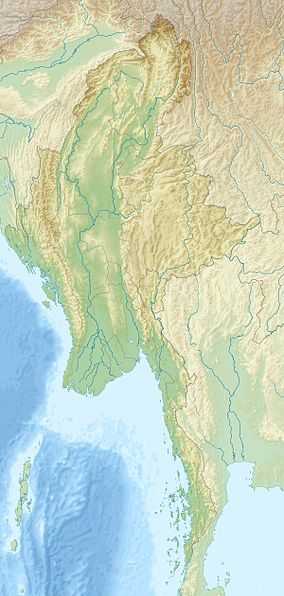Alaungdaw Kathapa National Park
| Alaungdaw Kathapa National Park | |
|---|---|
|
IUCN category II (national park) | |
 Location in Burma | |
| Location | Mingin Township, Sagaing Division , Burma. 1570 km north by north-west of Yangon |
| Coordinates | 23°36′N 95°32′E / 23.600°N 95.533°ECoordinates: 23°36′N 95°32′E / 23.600°N 95.533°E |
| Area | 1,605 km² (160,500 hectares) |
| Established | 21 July 1893 as Patolon Reserved Forest, 1941 as Alaungdaw Kathapa Wild Life Reserve |
The Alaungdaw Kathapa National Park, with an area of 1,605 square kilometers, is the largest national park in Burma (Myanmar). The park consists of the Patolon Reserved Forest and the adjoining Taungdwin Reserved Forest.
History
The Patolon Forest Reserve was originally established on 21 July 1893 and was enlarged in 1917. The Taungdwin Reserved Forest was established effective 1 December 1893. In 1941, Taungdwin was made into a wildlife sanctuary by the British colonial government, and it was upgraded to a national park in 1984 by the Burmese government.
Etymology
The National Park was named after a shrine to one of Buddha’s saintly disciples, Maha Kathapa (Maha Kassapa). This shrine dedicated to Alaungdaw Kathapa (literally, the embryo-Kathapa) is located inside the park boundaries. The shrine has a reclining figure called Kathapa and it is believed that his remains are kept under the shrine.
Topography
The National Park includes the upper catchment basins of the Petpa, Patolon and Taungdwin rivers. The Petpa River is a tributary of the Patolon. The Patolon and Taungdwin rivers drain the eastern and western parts of the park, respectively. These rivers are north flowing in steep sided valleys separated from each other and from adjoining valleys to the west and east by long north-south ridges that rise to elevations from 2000 to over 4000 feet. These parallel ridges are a series of cuestas, characterized by fairly steep escarpments on the eastern face with a moderate slope on the west.
The prominent ridge known as Mahudaung is the easternmost ridge in the park, and it forms the watershed between the broad settled valley of the Chindwin and the Patolon and the Petpa drainages to the west. Further west beyond the Taungdwin River, another high ridge, the Ponnyadaung, reaches a height of 4263 feet at Hlaingma Taung, and forms the western boundary of the park.
In the rainy season, numerous small waterfalls appear above the valleys, especially along the upper reaches of the Patolon and Petpa rivers. In the dry season, March through May, many of the smaller streams dry up. There are a number of perennial springs that keep the major rivers flowing.
Flora
Sagaing Division lies at the north of Myanmar's temperate dry zone. The Alaungdaw Kathapa National Park comprises two biomes : Temperate broadleaf and mixed and temperate coniferous forests.
The forests which exist in the national park are specialized as -
- Moist upper mixed deciduous forests
- Dry upper mixed deciduous forests
- Lower mixed deciduous forests
- Indaing forests
- Pine forests
Fauna
The park is home to large populations of wild elephants and other rare wildlife species. The most notable inhabitants are the large herds of Asian Elephants.
Other inhabitants include Thamin, Wild Pig, Gaur, Sambar, Banteng, Muntjak, Clouded Leopard, civets, Jungle Cats, Himalayan Brown Bear, Sun Bear, Oriental giant squirrel, Indian Giant Squirrel, Hog Badger, monitor lizards, macaques, Barking Deer and many types of birds. The elephants roam in groups of up to a dozen; 150-200 live in the area.
Wildlife monitoring by park rangers has shown the park to have a rich abundance of wildlife. Camera traps, visual sightings and animal tracks have revealed the existence of leopard, sun bear, banteng, gaur, wild dog and barking deer populations in the park. Villagers recently reported seeing a tiger in the park, which, if confirmed, would be the first sighting in over two decades when it was assumed that they had been hunted out to supply the illegal wildlife trade.
There also exists a wide variety of wild birds and fowls, including owls, hornbills, pheasants, parrots and eagles.
Conservation Work
The Ministry of Forestry, the National Commission of Environmental Affairs, a local NGO - FREDA (Forest Resource and Environmental Development and Conservation Association) and Wildlife Alliance carry out much of the conservation work. The Alaungdaw Kathapa National Park faced many daunting challenges to combat poaching, especially of the local deer and wild game population. The park is also one of the last safe havens of Myanmar's wild orchids, and thus, orchid hunters are also sometimes sighted.
The Alaungdaw Kathapa National Parki has a significant number of armed forest rangers, from the Ministry of Forestry. They have recently been able to turn the tide against poachers and the orchid hunters, although growing demand from China is putting greater burden on them.
Public
The Alaungdaw Kathapa National Park is one of the most famous parks with the Burmese populace. It is more of a religious site than a national park, drawing at least 30,000 pilgrims a year paying homage to wild pigs and tigers. The area itself is extremely isolated, elephants being the only means of transport to enter the park and forest.
A small group of monks care for the shrine of Alaungdaw Kathapa, and along with authorities from the Forestry Department and Nature and Wildlife Conservation Division coordinate to educate visitors about conservation and wildlife.
References
- Ministry of Hotels and Tourism, Department of Ecotourism http://myanmartravelinformation.com/mti-ecotourism/alaungdaw-kathaphar.htm''' ALaungdaw Kathapa National Park
- Aung Kyaw Sint, Ministry of Forestry. http://www.myanmar.gov.mm/Perspective/persp1999/3-99/fie.htm A Field Trip to Alaungdaw Kathapa National Park
- Wildlife Alliance http://www.wildlifealliance.org/where-we-work/thailand/surviving-together/alaungdaw-kathapa-national-park/''' Alaungdaw Kathapa National Park
- Travellingbirder.com http://www.travellingbirder.com/tripreports/view_birding_tripreport.php?id=407''' Field Trip Report, Alaungdaw Kathapa National Park
| ||||||||||||||